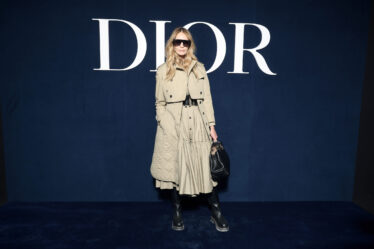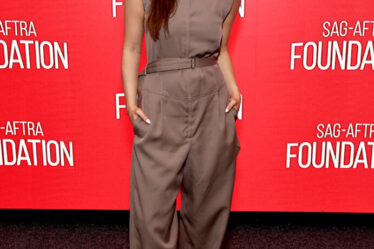Nearly five months after the height of “Brat” summer, Charli XCX’s selling power has hardly waned.
The singer has recently appeared in Converse’s holiday campaign, became the face of Valentino Beauty and Acne Studios, starred in a campaign and concerts for H&M and was featured in holiday ads for Shop with Google alongside fellow performer Troye Sivan. Brands just can’t seem to get enough of her.
The artist’s popularity hit a high note earlier this year with the release of her album “Brat,” which popularised an attitude embodied by the type of girl the artist described on TikTok as “a little messy and likes to party […] very honest, very blunt, a little bit volatile.” The term was quickly co-opted by social media users, while brands like hair care line K18 and Korean skincare company Laneige rushed to partner with Charli. In August, social media content featuring the star hit nearly 820 million impressions, according to creator marketing platform CreatorIQ.
But unlike the usual summer trends that fade the moment the weather changes, Charli XCX and “Brat” have outlasted the season. Experts say she’s tapped into a deeper cultural vein and managed to engender a devout loyalty among fans, cementing her recent appeal as more than a passing fad. (Her impressions remained above 620 million in October, CreatorIQ said.)
Interest has consequently remained high among fashion and beauty brands, which more and more are seeking celebrity partners who have powerful bonds with their fanbases. Her album and its updated version — “Brat and It’s Completely Different but Also Still Brat,” which dropped on October 11 — arrived at just the right moment to align with a broader cultural shift that cultural anthropologist Grant McCracken calls “wellness fatigue.”
“That’s where Charli XCX comes in,” he said. “People began to shift their allegiance away from wellness to a very different performance of self.”
Since about 2022, social media users have moved away from sharing a picture-perfect image of themselves online, an ideal that became known as “that girl,” and started adopting a more carefree, unfiltered “party girl” image, according to McCracken. He believes the change has contributed to the declining performance of brands like Lululemon and to brands marketed towards “party girls,” like skincare line 4am Skin, starting to take off.
Whether or not Charli XCX’s fans see her as a rejection of polished perfection and wellness culture, her connection with them seems to go beyond fun music. For fashion and beauty businesses, that means she offers an opportunity to connect with that audience on a deeper level — something they’re increasingly seeking as they look for stars who are open, true to themselves and even bring fans “into the creative process,” as H&M creative director Jörgen Andersson said.
Connecting with Niche Communities
Charli XCX’s attractiveness to brands isn’t just about the size of her audience; she has more of a niche following compared to some other artists. But it’s a loyal niche, which is arguably more important.
“The old marketing strategy used to be, ‘Let’s find somebody who is known to everyone and loved by everyone.’ That person almost always ended up being incredibly bland,” said McCracken.
Today, the consumer landscape is fragmented into a vast array of different groups and lifestyles, and connecting with small yet dedicated fanbases can be effective for brands looking to deepen their consumer relationships.
Alison Bringé, CMO of data analytics firm Launchmetrics, described Charli’s ability to build community as “bringing her fans into the temple,” adding “that whole kind of engagement campaign with the ‘Brat’ universe […] is what’s made her successful.”
The ease with which consumers adopted “Brat” as part of their identities and “slanguage,” as Cassandra Napoli, head of marketing at trend forecasting firm WGSN, called it, enabled the “Brat” idea to maintain its cultural relevance. Today the four Cs of marketing — “content, culture, commerce and community” — matter as much, if not moreso, when connecting with consumers than the traditional four Ps of product, price, place and promotion, said Napoli.
H&M took the four Cs to the next level with its Autumn/Winter 2024 campaign, launching a series of 13 global music events across eight cities. Charli, who first partnered with H&M at the start of her career in 2011, performed in H&M’s opening show in London as well as its recent surprise takeover of New York City’s Times Square, both of which were free for fans who signed up via a link.
To keep the event from feeling like a corporate show, H&M left the stage to Charli. “It was important for us to respect her and give her the creative space,” said Andersson.

The campaign clearly resonated. Launchmetrics tracked $1.2 million worth of value in media mentions the first week of Charli’s H&M campaign, compared to $752,000 for musician Raye’s partnership with the brand for the same stretch of time in January. Similarly, Charli’s partnership with Acne Studios drove $1.5 million in media mentions in the first 48 hours, compared to K-pop group ILLIT’s campaign with the brand, which drove $923,000 in the same time frame.
Because consumer groups have become so fragmented, it’s vital that brands work with a variety of different celebrities to reach their different audiences. Valentino Beauty, for example, saw the appeal of working alongside Charli to plug into a new consumer group. Bringé called Valentino’s beauty division “a very safe space for [the] brand” to partner with Charli, as “most luxury brand beauty arms are the first ones to enter with new voices and new faces that are a bit different than their typical ambassador, and that’s clearly because beauty categories are easier for aspirational customers to take their first dip into that luxury market.”
Aligning Values
Partnering with an artist like Charli XCX provides brands with another opportunity as well: They can align themselves with a set of values without having to state them explicitly.
Charli’s endorsement of US presidential candidate Kamala Harris with her post “Kamala IS brat” on X was big news, for example. For brands that are reluctant to publicise their political standing with an outright statement — as seen in this year’s US election — working with someone like Charli can enable them to more subtly signal their alignment with less risk of alienating some consumers.
Building partnerships rooted in shared values, rather than just working with the star du jour, can be more strategic for brands in the long run. As shoppers become more choiceful about who they align with, too, working with niche representatives who have deep ties to their community can also allow brands to have a greater impact over time.
“[It’s] about being intentional with time, energy and money, so making it last and stretch rather than just churn and burn,” WGSN’s Napoli said.
With fans deeply invested in learning about (and emulating) their favourite celebrities’ daily routines, collaborating with a star who actively incorporates a brand’s products into their life can back up the depth, authenticity and longevity of a partnership. Before officially partnering with Laneige, for instance, Charli shared that the brand’s Lip Sleeping Mask was one of her top 10 favourite items in an interview with British GQ, joking, “They are yet to send me any free product.” Before becoming the face of Acne Studios, she also wore the brand’s clothing while recording “Brat” and on tour.
Ensuring celebrity partners are genuine brand fans can insulate both parties from “[making] it seem like that creator is just doing a cash grab and has only a tenuous connection to the product,” said Alex Rawitz, CreatorIQ’s director of research and insights. Or as Napoli put it, it can keep Gen-Z from “getting the ick.”
Just finding a partner like Charli XCX isn’t enough to guarantee success, however. The future of celebrity marketing doesn’t only require brands to embed themselves within these kinds of existing cultural moments. They also have to take charge of crafting exciting opportunities for connection.
“If you’re going to be in culture as a brand, you can’t just expect to come in and jump on the bandwagon,” said Viktor Carlsson, senior project manager at H&M’s music agency Ohlogy. “You have to contribute. So create really special moments for fans, and listen to what the fans want.”


